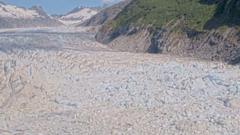Are Alaskans at Risk of Record Flooding Due to Glacial Melt?

Understanding the Risks of Glacier Lake Outburst Floods in Alaska
Recent events in Juneau, Alaska, have brought to light the urgent threat posed by glacial lake outburst floods (GLOFs). As meltwater escapes from a basin dammed by the Mendenhall Glacier, residents are facing the grim possibility of evacuations due to rising water levels. This phenomenon is not just a local concern; it highlights broader implications for climate change and glacial dynamics. In this article, we'll delve into the causes of GLOFs, their impacts on communities, and what can be done to mitigate these risks.
What Are Glacier Lake Outburst Floods?
Glacier lake outburst floods occur when a lake, typically formed by melting ice or snow, rapidly drains. This drainage can happen when the ice dam holding the water in place weakens or breaks, leading to a sudden and often catastrophic release of water. When the dam fails, it can unleash torrents of water that flow downstream, causing widespread flooding and destruction.
How Do GLOFs Occur?
The mechanism behind GLOFs involves several factors, primarily related to climate change:
- Meltwater Accumulation: Increased temperatures lead to more significant melting of glaciers and ice caps, resulting in the formation of large lakes.
- Ice Dam Failure: As these lakes accumulate water, the pressure against the ice dam can become immense. Eventually, the dam may either overflow or break, leading to a sudden release of water.
- Geological Factors: The surrounding terrain can also influence how quickly and violently these floods occur. Steep slopes can exacerbate the speed and volume of water flow.
The Current Situation in Juneau
As of the latest updates, the National Weather Service (NWS) in Juneau has issued flood warnings due to rising water levels in the Mendenhall River. On Tuesday, water levels reached alarming heights of 9.85 feet, and by Wednesday morning, they exceeded 16 feet, indicating a crest. This rapid escalation has raised concerns among local officials and residents.
Evacuations and State Responses
In response to the imminent threat, Alaska Governor Mike Dunleavy has declared a state disaster. This declaration underscores the severity of the situation and aims to mobilize resources for affected communities. Local officials have been proactive in warning residents about potential evacuations, emphasizing the need for preparedness in the face of rising waters.
The Historical Context of Flooding in Juneau
Flooding has been a recurring issue in the Juneau area since at least 2011. In recent years, the frequency and severity of these events have increased, with hundreds of homes affected last year alone. This trend raises important questions about climate resilience and emergency preparedness in a region that is already grappling with the impacts of climate change.
Lessons from Previous Flood Events
Past flooding events in Juneau have provided valuable lessons in disaster management:
- Community Preparedness: Residents must be educated about the risks of GLOFs and the appropriate actions to take in case of an emergency.
- Infrastructure Improvements: Investing in flood-resistant infrastructure can help mitigate the impacts of future flooding.
- Emergency Response Plans: Local authorities should have clear and effective emergency response plans tailored to the unique risks posed by glacial outburst floods.
The Role of Climate Change
Climate change is a significant driver of the conditions leading to GLOFs. As global temperatures rise, glaciers are melting at an unprecedented rate, leading to the creation of new glacial lakes. With more meltwater accumulation, the potential for catastrophic flooding increases dramatically.
Understanding the Climate-Glacier Relationship
Glaciers act as natural reservoirs, storing water that is gradually released over time. However, when these glaciers melt too quickly, the balance is disrupted, resulting in a rapid influx of water into lakes. The relationship between climate change and glacier dynamics is a critical area of study for scientists seeking to predict future GLOFs.
Mitigating the Risks of GLOFs
While the threat of GLOFs cannot be entirely eliminated, there are several strategies that can help mitigate their impacts:
- Monitoring and Early Warning Systems: Implementing advanced monitoring systems can help track changes in glacier dynamics and water levels, providing early warnings to communities.
- Community Engagement: Educating residents about GLOFs and emergency preparedness can empower them to take action when necessary.
- Research and Data Collection: Ongoing research into glacier behavior and climate patterns is essential for understanding and predicting future GLOF events.
Conclusion
The current situation in Juneau serves as a stark reminder of the risks associated with glacier lake outburst floods. As climate change continues to alter our environment, communities must be vigilant and prepared. By understanding the science behind GLOFs and implementing effective mitigation strategies, residents can better protect themselves and their homes from the devastating impacts of these natural disasters.
FAQs About Glacier Lake Outburst Floods
What causes glacier lake outburst floods?
GLOFs are caused by the rapid drainage of lakes formed by melting glaciers, typically when the ice dam holding the water fails or overflows.
How can communities prepare for GLOFs?
Communities can prepare by implementing early warning systems, educating residents about risks, and investing in flood-resistant infrastructure.
What is the impact of climate change on glaciers?
Climate change accelerates the melting of glaciers, leading to increased water levels in lakes and a higher risk of glacier lake outburst floods.
As we observe the unfolding situation in Juneau, it prompts us to reflect on our preparedness for natural disasters exacerbated by climate change. What measures can communities take to ensure safety and resilience in the face of such threats? #GlacierFloods #ClimateChange #JuneauPreparedness
Published: 2025-08-13 11:56:06 | Category: wales



